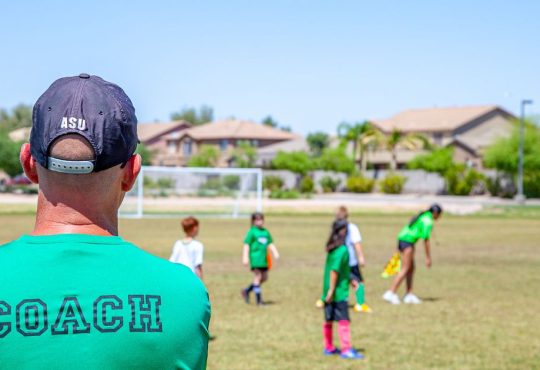Football, the beautiful game, has captivated millions worldwide for over a century. But like any beloved tradition, it’s not immune to change. As technology, culture, and economics evolve, so too does football. What will the future hold for this global sport? Will we see groundbreaking changes in how the game is played, consumed, and managed? Let’s dive into some intriguing predictions and explore the exciting changes in football that may be on the horizon.
As fans, we’ve seen football evolve from grainy black-and-white broadcasts to vibrant HD spectacles, from local clubs to global brands. But what’s next? The upcoming years promise even more dramatic transformations, driven by advancements in technology, shifts in fan engagement, and new approaches to player development and health. Whether you’re a die-hard supporter or a casual observer, these potential changes in football will keep you on the edge of your seat.
Technological Innovations
VAR and Beyond
The introduction of Video Assistant Referee (VAR) has already revolutionized football by providing referees with technology to review decisions. However, the future holds even more potential for technological advancements. Imagine AI-powered referees capable of making instant, accurate decisions, reducing human error, and speeding up the game.
- AI Referees: These systems could analyze live match data, ensuring fair play and precision in decision-making. Utilizing machine learning algorithms, AI referees could be trained on thousands of game scenarios, making them adept at recognizing fouls, offsides, and other infractions more consistently than human referees.
- Enhanced VAR: Future iterations of VAR could include 3D modeling and real-time analysis, offering deeper insights into every call. Advanced 3D technology could reconstruct controversial moments from multiple angles, providing a comprehensive view that ensures the most accurate decisions. Additionally, real-time data processing could shorten review times, keeping the game’s flow uninterrupted.
Wearable Tech
Wearable technology has made its way into football, but its role is set to expand significantly. Players already use devices to track their performance, but what if this data could be used in real-time to make tactical adjustments during a match?
- Smart Wearables: These devices could monitor players’ vitals, predicting injuries before they happen. Equipped with advanced sensors, smart wearables could track metrics like heart rate, muscle strain, and hydration levels. This data could then be used to predict and prevent injuries, ensuring player health and longevity.
- In-Game Adjustments: Coaches could receive live data on players’ conditions, allowing for immediate strategic changes. Imagine a coach being alerted to a player’s fatigue levels or minor injuries in real-time, enabling timely substitutions and tactical tweaks that could turn the tide of a match. Furthermore, this data could help customize training programs, focusing on areas needing improvement and reducing overtraining risks.
Virtual Reality (VR) and Augmented Reality (AR)
- VR Training: Virtual reality could provide immersive training experiences, simulating different game scenarios for players. This technology would allow players to practice set-pieces, strategies, and positioning in a controlled environment that replicates the pressures of a live match.
- AR Analysis: Augmented reality could be used to overlay tactical information on live game footage, assisting coaches and players in making quick, informed decisions. For example, AR glasses could highlight optimal passing lanes or identify defensive gaps in real-time, enhancing on-field communication and strategy execution.
Fan Engagement
Virtual and Augmented Reality
Imagine watching a match from the comfort of your home but feeling like you’re in the stadium. Virtual and Augmented Reality (VR and AR) technologies are set to transform the fan experience.
- VR Stadiums: Fans could experience the thrill of being at a live match without leaving their living room. By donning VR headsets, fans could enjoy a 360-degree view of the stadium, feel the energy of the crowd, and watch the game from various vantage points, from the stands to the sidelines. This immersive experience would make them feel like they’re part of the action, enhancing the excitement and emotional connection to the game.
- AR Enhancements: Augmented reality could provide additional layers of information, such as player stats and historical data, overlaid on the live game feed. For instance, fans could use AR glasses or mobile apps to see real-time data about players’ speed, distance covered, and even biometric readings. Historical match data and player biographies could pop up, providing context and enriching the viewing experience. Imagine watching a goal and instantly receiving insights into the player’s form, past performance, and career highlights, all while never taking your eyes off the game.
Interactive Viewing
The way we watch football is changing. Traditional broadcasts are giving way to interactive viewing experiences that allow fans to engage with the game like never before.
- Second-Screen Experiences: Apps and platforms could offer real-time stats, multiple camera angles, and interactive polls. During a match, fans could use their smartphones or tablets to access a wealth of information. They could switch between different camera angles, watch replays, and analyze stats like possession, shots on target, and player heatmaps. Interactive polls and quizzes could keep fans engaged during breaks in play, making them feel more connected and informed.
- Fan Participation: Viewers might vote on tactical decisions or predict match outcomes, influencing the game in new ways. Imagine a scenario where fans can vote on substitutions or formation changes through an app, with the most popular choices being considered by the coaching staff. While it may not directly dictate decisions, this level of interaction would make fans feel like active participants in the game. Predictive games could also allow fans to compete against each other by forecasting match events, such as the next goal scorer or the final score, with leaderboards and prizes adding to the excitement.
Player Development and Health
Advanced Training Techniques
Training methods are evolving, with clubs investing in cutting-edge technology to improve player performance. The future of football training could look very different.
- Simulated Environments: Virtual reality training could simulate match conditions, allowing players to practice without the risk of injury. VR technology can recreate various game scenarios, from high-pressure penalty shootouts to defending against set pieces. Players can hone their skills in a controlled environment, enhancing their decision-making and reaction times without the physical wear and tear associated with traditional training. This method also allows for unlimited repetition of specific scenarios, aiding in muscle memory development.
- Biomechanics: Detailed analysis of player movements could lead to personalized training regimens that maximize performance and minimize injury. Using motion capture and other advanced technologies, coaches and trainers can analyze every aspect of a player’s movements, from their running gait to the way they strike the ball. This data can identify inefficient or risky movements, allowing for tailored training programs that focus on improving technique, increasing efficiency, and reducing the likelihood of injury. Additionally, players can receive feedback on their performance in real-time, making it easier to correct errors and improve their overall game.
- Data-Driven Nutrition: Personalized nutrition plans based on biometric data can optimize player diets for peak performance. Using data from wearable devices and regular health checks, nutritionists can tailor meal plans that meet the specific needs of each player, ensuring they get the right balance of macronutrients and micronutrients to support training and recovery.
- Sleep and Recovery Technology: Advanced sleep tracking and recovery tools can help players optimize their rest and rehabilitation. Proper sleep is critical for athletic performance, and modern technology can monitor sleep patterns, providing insights into the quality and duration of rest. This data helps in creating personalized recovery plans that might include tailored sleep schedules, light therapy, and other interventions to ensure players are fully rested and ready for peak performance.
Mental Health and Wellbeing
The physical demands of football are well-documented, but mental health is increasingly recognized as equally important. Future changes in football will likely see a greater emphasis on holistic player wellbeing.
- Mental Health Support: Clubs could provide more robust mental health resources, helping players cope with the pressures of professional sport. This might include access to sports psychologists, mindfulness and meditation programs, and regular mental health check-ins. By normalizing mental health care and providing players with the tools to manage stress and anxiety, clubs can help ensure their players maintain a healthy mind as well as a healthy body.
- Comprehensive Health Programs: Integrated health programs that address both physical and mental aspects could become standard. These programs could offer a holistic approach to player health, incorporating physical training, mental health support, and lifestyle management. For example, wellness workshops could cover topics like financial planning, social media use, and work-life balance, all aimed at helping players lead well-rounded, healthy lives.
- Resilience Training: Techniques such as cognitive behavioral therapy (CBT) and resilience training can help players develop mental toughness. These methods can teach players how to handle the highs and lows of professional sport, from managing the pressure of high-stakes matches to dealing with injuries and setbacks. Building resilience can help players maintain their performance and wellbeing over the long term.
- Community and Social Support: Strong community and social support networks within clubs can foster a sense of belonging and camaraderie among players. Team-building activities, mentorship programs, and social events can strengthen bonds within the team, providing players with a robust support system.
Globalization and Economics
Emerging Markets
Football’s popularity is spreading to new regions, and emerging markets could become the sport’s new powerhouses.
- Investment in Asia and Africa: With growing fan bases, countries in these continents are investing heavily in football infrastructure.
- Global Talent Pools: Clubs might scout and develop talent from a more diverse range of countries.
Financial Fair Play
Economic disparities between clubs have been a persistent issue in football. Future changes in football’s financial regulations could aim to create a more level playing field.
- Revised Fair Play Rules: Stricter enforcement and new rules could prevent financial imbalances and promote sustainability.
- Revenue Sharing: Greater revenue sharing among clubs could help smaller teams compete with giants.
Environmental Sustainability
Green Stadiums
Football clubs are becoming more aware of their environmental impact, leading to a push for sustainability.
- Eco-Friendly Stadiums: Future stadiums could be built with sustainable materials and powered by renewable energy.
- Carbon Neutral Clubs: Clubs could adopt practices to reduce their carbon footprint, from travel policies to recycling programs.
Community Initiatives
Football clubs have the power to drive social change. Future initiatives could focus on broader societal issues, leveraging the sport’s global reach.
- Grassroots Programs: Investments in community programs could promote football at the grassroots level, encouraging participation and healthy lifestyles.
- Social Responsibility: Clubs could lead campaigns on issues like equality, inclusion, and mental health, using their platform for positive change.
Conclusion
The future of football promises to be as exciting as its past, with technology, fan engagement, player health, and sustainability driving significant changes in football. Whether it’s the introduction of AI referees, the use of VR for immersive fan experiences, or the emphasis on holistic player development, these predictions highlight a sport that’s continuously evolving. As fans, we have front-row seats to this transformation, witnessing how football adapts and grows in response to new challenges and opportunities.
In a world that’s constantly changing, football remains a constant source of joy and passion for millions. The changes in football that lie ahead will undoubtedly shape the way we play, watch, and experience the game. By embracing these innovations and addressing the challenges, the sport can continue to thrive, bringing people together in celebration of the beautiful game. With a blend of tradition and innovation, football’s future looks brighter than ever.





